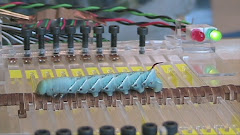Everybody in my lab knows me for training caterpillars to perform various sportive activities. Well, inducing caterpillars to crawl underwater was a true story. My motivation was to test the role of gravity and external pressure on a behaving animal. As it turned out, 5th instar caterpillars float in water and thus experienced a force negative to gravity, but none of the kinematics characteristics changed. See my video "Manduca underwater walk" on YouTube.
Looking closely, I found that bubbles could be seemed to come out of the spiracles as the animal compressed itself. This observation illustrated the potential change of body volume due to tracheal compression (see video). If caterpillars can squeeze air out under the influence of water pressure, they must perform quite a lot of gas exchange in the air. In other words, locomotion facilitates gas exchange by compressing and squeezing the air out of the trachea.
Finally, I would like to share a video I shot the other day when one big caterpillar was crawling on top of a smaller one. It's quite an pathetic scene because the smaller caterpillar was actually in the molting process and could not fight back. Nevertheless, as the big caterpillar crawled along, I observed appropriate deformation on the substrate (in this case another caterpillar) as illustrated by my new ground reaction forces paper (to appear in Journal of Experimental Biology).
Subscribe to:
Post Comments (Atom)

.jpg)
No comments:
Post a Comment